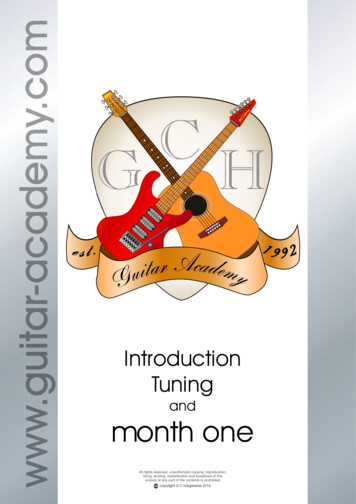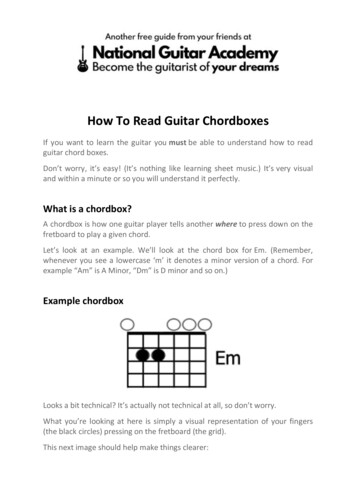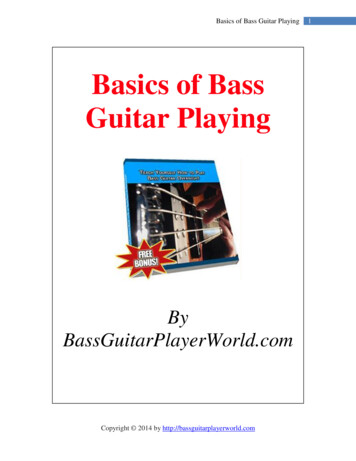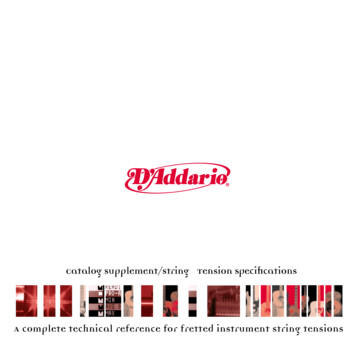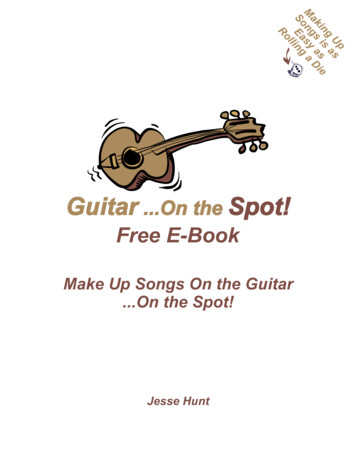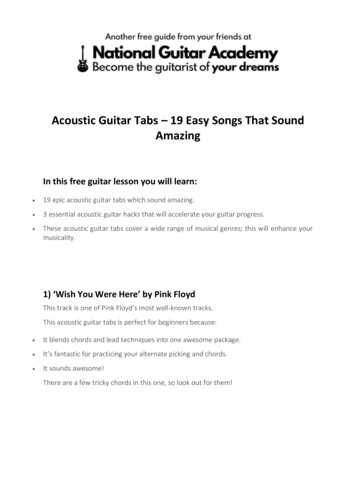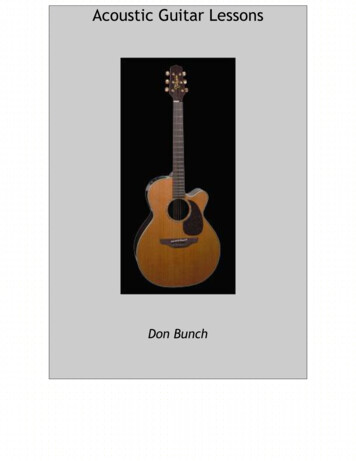
Transcription
Acoustic Guitar LessonsDon Bunch
Guitar Lessons OutlineGuitar Lessons Outline .2Lesson 1: Introduction to the Guitar .3Guitar Terms .3Holding the guitar .4Holding the Pick .4Lesson 1: Worksheet .5Lesson 2: Tuning the Guitar .6Standard Tuning .6Chromatic Scale .7Major Scale .8Lesson 2: Worksheet .9Lesson 3: Major Chords . 11Basics. 11Chord Triads. 12Chord Families . 13Lesson 3: Worksheet . 16Lesson 4: Minor Chords . 18Relative Minors . 18Flattened 3rd Note . 19Lesson 4: Worksheet . 24Lesson 5: Seventh Chords . 267th Inning Stretch . 26Minor Sevenths . 27Major Sevenths. 27Lesson 5: Worksheet . 29Lesson 6: Barre Chords . 31E formation: Major, Minor, Sevenths . 31A formation: Major, Minor, Sevenths . 33Lesson 6: Worksheet . 34Lesson 7: Basic Rhythms. 36Down & Up Strokes . 36Riding the Bass . 37Jig beat . 37Lesson 8: Major Scales . 38First Position Major . 38Second Position Major . 39Third Position Major . 40Lesson 9: Transposing . 42Lesson 10: Chord Progressions . 432
Lesson 1: Introduction to the GuitarGuitar TermsCongratulations on buying a new guitar! In order to become a guitarist, youshould learn the parts of the guitar. The major parts of the guitar arediscussed in terms of its body: the top of the guitar is the “head”, thefingerboard/fretboard is on the “neck” and the soundhole is usually centeredin the “body”.The tuners are usually made of metal or tortoise shell. The tuners are woundcounter-clockwise from their positions on the head when strung. The nut iswhite plastic piece at the bottom of the head. The nut is the starting point ofthe string that produces a note when plucked. The ending point is the saddle,which is the white plastic piece in the center of the bridge. For instance, thefirst string in a standard tuning is an “E” note (it is also referred to as the “E”string). The face of the neck is called the fretboard. The frets are the spacesbetween the fret wires on the fretboard. The space between the nut and thefirst fret wire is the 1st fret. When you press the E string on the 1st fret, youshorten the length of the string that vibrates, creating a higher pitch (the “F”note).The position markers are usually found on the fretboard and on the side of theneck. These are dots which indicate the 3rd, 5th, 7th, 9th, 12th, 15th and 17thfrets on an acoustic guitar. The soundhole allows the sound to project fromthe body. The pickguard is designed to protect the body from being scratched.Not all guitars have pickguards, but when you look at the holes in the body ofWillie Nelson’s guitar you can see why they are important. The bridge is the3
wooden piece attached to the center of the body. The bridge anchors thestrings to the body of the guitar either with pegs or through holes in the bridge.Holding the guitarI usually play my guitar while standing up, but you’ll probably want to sit downwhile you are learning to play. Get an armless chair or sit on a sofa. Youshould sit upright. Now, pick up your guitar, and hold it so the back of thebody of the instrument comes in contact with your stomach/chest, and thebottom of the neck runs parallel to the floor. The thickest string on the guitarshould be the closest to your face, while the thinnest should be closest to thefloor. Typically, a right-handed person will hold the guitar so the headstockpoints to the left, whereas a left-handed person will hold the guitar so theheadstock points to the right. Left-handed people need a left-handed guitar.A right-handed guitarist should hold the guitar on his right leg and the lefthanded guitarist should hold the guitar on his left leg. Your dominant hand isused for picking and strumming the strings while the non-dominant handbecomes your "fretting hand". The thumb of your fretting hand should restbehind the neck of the guitar, with your fingers in a slightly curled position.Holding the PickFind, buy or borrow some guitar picks. You can experiment with differentshapes and brands, but most people use medium gauge picks to start. Hold apick in your dominant hand as shown in this photo. Be sure the pointed end ofthe pick is pointing directly away from your fist, and is out about a half aninch. I usually hold the pick closer to the end of my thumb. Hold the pickfirmly.4
Lesson 1: WorksheetFill in the blanks with the appropriate guitar terms without looking at theprevious pages.1.2.3.4.5.6. /7.8.9.10.11.12.13.14. A right-handed guitarist holds the pick in his hand andfingers the fretboard with his hand.15. The head of the guitar is held to your if you are a right-handedguitarist.5
Lesson 2: Tuning the GuitarStandard TuningBefore you begin playing, you must also know how the frets and strings arenumbered (See Figure Below). The strings are numbered from the lightest(thinnest) to the heaviest (thickest). So the thinnest string is the 1st string andthe thickest is the 6th string. A guitar in standard tuning is tuned to E-A-D-G-BE. In other words, 6th string - Low E, 5th string -A , 4th -D, 3rd -G, 2nd -B, 1st High E. Look at the diagram to find out how the frets are numbered. The 0 fretis also the open note on each string.To tune your guitar, you only need to have one string tuned to any note, aslong as you know which one it is. This is known as the reference point. Onceyou have this, tuning the rest of the strings is easy. There are various ways tofind the reference point. You can use any of the following methods to tune onestring or all your strings.Piano/Keyboard: A keyboard is an excellent way to tune your guitar. Just tunethe strings by matching them with their respective keys. The piano diagramcovers one octave while the guitar diagram covers two octaves.Electronic Tuner: Allows you to tune the guitar string by measuring thefrequency of the string. Some tuners have a switch for each string while othersare chromatic. The chromatic tuner will identify the note you are playing andwill indicate whether you are below the pitch (flat) or above the pitch (sharp).6
Follow these instructions for tuning your guitar, with the top string beingalready tuned to an E.E -0-- 1stB ---- 2ndG ---- 3rdD ---- 4thA ---- 5thE ---- 6thStep1Step 2Step 3Step 4Step 5Place your finger on the 5th fret of the 6th string and tune the 5thstring until both match.Place your finger on the 5th fret of the 5th string and tune the 4thstring until both match.Place your finger on the 5th fret of the 4th string and tune the 3rdstring until both match.Place your finger on the 4th fret of the 3rd string and tune the 2ndstring until both match.Place your finger on the 5th fret off the 2nd string and tune the 1stuntil both match.Chromatic ScaleA chromatic scale includes all 12 notes in a standard octave. This may seemconfusing at first because the definition of an octave is an 8-note scale wherethe 1st note and the 8th note are the same pitch. For example, in a standard“C” scale, the 1st note and the 8th note of that scale would both be “C”.However, a chromatic scale includes every half-note step in between the two“C’s”. A “#” symbol means sharp and a “b” symbol means flat or ½ step aboveor below the whole tone respectively, so the chromatic scale from “C” to “C”is:CC#/DbDD#/EbEFF#/GbGG#/AbAA#/BbBCA half-step above E is F and a half-step above B is C, so there is no E#/Fb or aB#/Cb. Below the notes of the fretboard are diagramed. Notice that by thetime you get to the 5th fret of each string, you are overlapping the notes of thenext string.7
Major ScaleI mentioned the octave in the explanation of the chromatic scale. Now I willexplain how the eight notes of the major scale are chosen. The major scalecan start with any note on the chromatic scale. This note is known as the rootnote. In order to determine which notes are included in the scale we followthis pattern: W-W-H-W-W-W-H (W - Whole Step, H - Half Step). This gives youan eight-note scale of Root -2-3-4-5-6-7-Octave, where the octave is a higherpitch of the same note.For example, in the “C” scale, we would choose the following notes from thechromatic scale:Root23RootWWCC#/Db D D#/Eb E4567 OctaveHWWWHF F#/Gb G G#/Ab A A#/Bb BCSo, the “C” scale is C,D,E,F,G,A,B and C. This is the easiest key to rememberbecause it has no sharps or flats.In order to practice this concept, let’s construct a major scale in the key of“G”. We’ll start from the “G” note in the center of the chromatic scale andfollow the W-W-H-W-W-W-H pattern to find our notes.CC#/DbDD#/EbEFF#/GbGG#/AbAA#/BbBCFirst we express the chromatic scale with G at the start and get:GG#/AbAA#/BbBCC#/DbDD#/EbEFF#/GbGThen we use our pattern to choose the notes of the G major scale:Root23RootWWGG#/Ab A A#/Bb B456HWWC C#/Db D D#/Eb EF7OctaveWHF#/GbGThe key of G has one sharp expressed as F#, because we already have a G noterepresented in the scale.8
Lesson 2: Worksheet1. Practice tuning your guitar in a standard E-A-D-G-B-E tuning using apiano/keyboard, an electronic tuner, or with manual tuning.2. Fill in the notes of the chromatic scale starting with the C note:3. Using the chromatic scale and the W-W-H-W-W-W-H pattern, find the notesof the following major scales:RootRootABCDEFG2W3W4H5W96W7WOctaveHABCDEFG
Answers1. Follow lesson steps.2. Fill in the notes of the chromatic scale starting with the C note:CC#/DbDD#/EbEFF#/GbGG#/AbAA#/BbBC3. Using the chromatic scale and the W-W-H-W-W-W-H pattern, find the notesof the following major scales:RootRootABCDEFG2WBC#DEF#GA34W HC# DD# EEFF# GG# AA BCDEFG
Lesson 3: Major ChordsBasicsNow that you’ve learned guitar terms and the basics of music, you are ready tostart learning chords. When you use your fretting hand to press the stringsdown on the frets of your guitar, you will start creating chords. It’s just asimportant to learn what notes you are playing as it is to learn the chordformation in order to become proficient at the guitar.First, remember that the standard tuning of a guitar is:E, A, D, G, B, E (you can remember it as Eat All Day Get Big Easy)6E5A4D3G2B1EYou also need to know how your fingers are numbered for fretting the notes:11
Chord TriadsIn Lesson 2, you became familiar with the notes of several major scales (C, D,E, F, G, A & B). Now you will learn how to use the Root note, the 3rd note andthe 5th note of each scale to form major chords. Remember that in the key ofC there are no sharps or flats, so the C major scale is:Root23RootWWCC#/Db D D#/Eb E4567 OctaveHWWWHF F#/Gb G G#/Ab A A#/Bb BCNow you will use the root (C), the 3rd note (E) and the 5th note (G) to form a Cmajor chord.The lowest note of chords is usually the root note, so for the C-major chord;you will not play the 6th string (X denotes not playing the string). Starting on5th string, you will make a C-note by pressing the 3rd fret with your 3rd finger.On the 4th fret, you will make an E-note by pressing the 2nd fret with your 2ndfinger. The 3rd string is left open because it is a G-note when open (0 denotesan open string). On the 2nd string, you will make a C-note by pressing the 1stfret with your 1st finger. The 1st string is left open because it is an E-notewhen left open.After you’ve formed this chord, practice picking the strings from the 5th stringdown to the 1st string. Each note of the chord should ring. If the note soundsdull, you may be unintentionally pressing one of the strings with the wrongfinger. Next, we’ll start to learn about chord families and get one step closerto playing some songs!12
Chord FamiliesLet’s move to another easy key to play: G-MajorRoot23RootWWGG#/Ab A A#/Bb B456HWWC C#/Db D D#/Eb EF7OctaveWHF#/GbGUsing the root (G), the 3rd note (B) and the 5th note (D), you will make the Gmajor chord this way:This chord may also be played with your 1st, 2nd and 3rd fingers, but learning toplay the G-major chord with the above fingering will help you move from the Gchord to the C chord more easily.Chord families are chords made from the major scale. Most rock and folk tunesare based on chords formed from the root note, the 4th note and the 5th note.In the key of G major these chords would be: G major, C major and D major13
Practice playing these chords by picking each of the strings without an X listedabove them. Below are examples of a couple of songs you can play with justthese three chords:Sweet Home Alabama (Lynyrd Skynyrd)D C G (repeat)D CGDCGBig wheels keep on turning; carry me home to see my kin.DCGSinging songs about the Southland,DCGI miss old ‘Bamy once again and I think it’s a sinDCGDCGWell I heard Mr. Young sing about her, I heard ole Neil put her downDCGI hope Neil Young will rememberDCGA southern man don’t need him around anyhowDCGDCGSweet home Alabama, where skies are so blueDCGDCGSweet home Alabama, Lord I’m coming home to youIn Birmingham they love the governorNow we all did what we could doNow Watergate does not bother meDoes your conscience bother you?Tell the truthNow Muscle Shoals has got the SwampersAnd they've been known to pick a song or twoLord they get me off so muchThey pick me up when I'm feeling blueNow how about youThere is one point in this song where an F major chord is used, but you canalways learn that later! For the most part Sweet Home Alabama is just Dmajor, C major, G major played over and over again. On the next page you’llfind the words and chords to The Joker by Steve Miller, another three chordsong.14
The Joker (Steve Miller)Intro: G C D C (2X)GSomeGSomeGSomeCDCpeople call me the space cowboy, yeahCDCcall me the gangster of loveCDCpeople call me MauriceGCDCGCause I speak of the pompitous of loveCDC GPeople talk about me, babyCDCGSay I'm doin' you wrong, doin' you wrongCDCWell, don't you worry baby, don't worryGCDC‘Cause I'm right here, right here, right here, right here at homeGCGC‘Cause I'm a picker, I'm a grinner, I'm a lover and I'm a sinnerGCDCI play my music in the sunGCGCI'm a joker, I'm a smoker, I’m a midnight tokerGCDCI sure don't want to hurt no one(Repeat)(2X) – (I get my lovin' on the run)You're the cutest thing that I ever did seeI really love your peachesWant to shake your treeLovey-dovey, lovey-dovey, lovey-dovey all the timeOoo-eee baby, I'll sure show you a good time (chorus)People keep talking about me babyThey say I'm doin' you wrongWell don't you worry, don't worry, no don't worry mama‘Cause I'm right here at homeYou're the cutest thing I ever did seeReally love your peaches want to shake your treeLovey-dovey, lovey-dovey, lovey-dovey all the timeCome on baby and I'll show you a good time15
Lesson 3: Worksheet1. Using the 1, 3, and 5 pattern to form major chords: diagram the followingmajor chords:A MajorB MajorC MajorD MajorE MajorF MajorG Major16
Answers17
Lesson 4: Minor ChordsRelative MinorsThe relative minor chord of any key can be found by using the 6th note of thatkey as the root of a chord. For example, the relative minor of C major is Aminor, because A is the 6th note of the C major scale and the A-minor scale hasthe same notes as the C-major scale. Below is the C-major taveCThe minor scale starts with the root and follows this pattern: W-H-W-W-H-W-W.Below is the A-minor , the relative minor chord of C-major is A-minor, formed from theRoot, 3rd and 5th notes of the A-minor scale: A-C-E18
Flattened 3rd NoteThe music theory above may be too involved at this point for making minorchords, so here’s a shortcut. Take any major chord and flatten at least one ofthe 3rd notes in that chord. For example:becomesThe 3rd note of the A major scale is C#, so the flattened 3rd note would be C.Here’s another example:becomesThe 3rd note of the D major scale is F#, so the flattened 3rd note would be F.Ok, one more:becomesThe 3rd note of the E major scale is G#, so the flattened 3rd note would be G.19
Here are some songs you can play now that you’ve mastered a few minorchords. They have the chords (G-C-D) in them with the relative minor chord ofG major: E minor!Wonderful TonightEric ClaptonGDCDIt's late in the evening; she's wondering what clothes to wearGDCDShe puts on her make up and brushes her long blonde hairCDGG/F# EmAnd then she asks me, Do I look al-right?CDGG D C DAnd I say yes, you look wonderful tonightGDCDWe go a party and everyone turns to seeGD/F#CDThis beautiful lady that's walking around with meCDGG/F# EmAnd then she asks me, do you feel alright?CDGAnd I say yes, I feel wonderful tonightCDGG/F# EmI feel wonderful because I see the love light in your eyesCDCDAnd the wonder of it all is that you just don't realizeGGD C D G D C DHow much I love youGDCDIt's time to go home now and I've got an aching headGDCDSo I give her the car keys she helps me to bedCDG G/F#EmAnd then I tell her as I turn out the lightCDGG/F# EmI say my darling, you were wonderful tonightCDG D C D G D C D GOh my darling, you were wonderful tonighthttp://www.thetabworld.com/Clapton Eric Wonderful Tonight guitar chord.html20
StayJackson Browne(D)G Em(. People,) stayCDG Em C Djust a little bit longer.DG Em CDG Em C DWe wanna play just a little bit longer.GEm C DThe promoter don't mind.GEm C DAnd the union don't mindGEmCDif we take a little time and we leave it all behindEmsing one more song.G Em CDG Em C DOh, won't you stay just a little bit longer.GEmCDEmPlease, please, please say, you will. Say you will.G Em CDG Em C DOh, won't you stay just a little bit longer.GEmCDG Em C DOh, please, please stay just a little bit more.GEmCnow the promoter don't mind.GEmCAnd the roadies don't mind,DDGEmCDEmif we take a little time and we leave it all behind sing one more song.http://www.thetabworld.com/Jackson Browne Stay guitar chord.html21
Brown Eyed GirlVan MorrisonGCGDHey where did we go, days when the rains came?GCGDDown in the hollow, playin' a new game,GCLaughing and a running hey, heyGDSkipping and a jumpingGCIn the misty morning fog withGDCOur hearts a thumpin' and youDG Em CDGMy brown eyed girl,you my brown eyed girl.Whatever happened to Tuesday and so slow?Going down the old mine with a transistor radioStanding in the sunlight laughing,Hiding behind a rainbow's wall,Slipping and slidingAll along the water fall, with youMy brown eyed girl, you my brown eyed girl.DGDo you remember when we used to sing?GCGDSha la la la la la la la la la la te daSo hard to find my way, now that I'm all on my own.I saw you just the other day, my how you have grown,Cast my memory back there, LordSometime I'm overcome thinking 'boutMaking love in the green grassBehind the stadium with youMy brown eyed girl, you my brown eyed girlDo you remember when we used to sing?Sha la la la la la la la la la la te da.22
Country RoadsJohn DenverGEmAlmost heaven West VirginiaDCGBlue Ridge Mountains Shenandoah RiverGEmLife is old there older than the treesDCGYounger than the mountains blowin' like a breezeGDCountry roads take me homeEmCTo the place I belongGDWest Virginia mountain mommaCGTake me home country roadsAll my memories gather round herMiner's lady stranger to blue waterDark and dusty painted on the skyMisty taste of moonshine teardrop in my eyesCountry roads take me homeTo the place I belongWest Virginia mountain mommaTake me home country roadsEmDCGI hear a voice in the morning how she calls meCDGThe radio reminds me of my home far awayEmFCDrivin' down the road I get a feelin'GG7That I should been home yesterday yesterdayCountry roads take me homeTo the place I belongWest Virginia mountain mommaTake me home country roadsTake me home down country roads.23
Lesson 4: Worksheet1. What is the relative minor chord of G major?2. What are the notes of that chord?3. Using the 1, 3b, 5 pattern to form minor chords: diagram the followingmajor chords.A MinorB MinorE MinorF Minor24D Minor
Answers1. What is the relative minor chord of G major? E minor2. What are the notes of that chord? E-G-B3. Using the 1, 3b, 5 pattern to form minor chords: diagram the followingmajor chords.25
Lesson 5: Seventh Chords7th Inning StretchWhether you intend to play rock, country or folk tunes, you will definitely want tolearn how to play major and minor 7th chords because they add flavor to a song likecilantro adds flavor to eggs.7th chords are very easy to make: take any major chord and introduce at least onenote that is the flattened 7th note of that chord’s major scale. For example:becomesThe 7th note of an A major scale is a G#, so a flattened 7th note would be G.Here’s another example:becomesThe 7th note of a D major scale is a C#, so a flattened 7th note would be C.26
Minor SeventhsThere are two rules to making minor chords: first you make the major chord into aminor chord by flattening the 3rd note and then you add a flattened 7th note. Forexample:becomesThe 3rd note of the A major scale is C#, so the flattened 3rd note would be C.The 7th note of the A major scale is a G#, so a flattened 7th note would be G.Here’s another example:becomesThe 3rd note of the D major scale is F#, so the flattened 3rd note would be F.The 7th note of the D major scale is a C#, so a flattened 7th note would be C.Major SeventhsThe major seventh chord should not be confused with the seventh chord. Thedifference between an A7 and an Amaj7 is that the 7th note of the major scale is notflattened in a major seventh chord. This makes a major seventh chord fairly easy tomake since you just drop one of the eighth notes down a half step to add a seventhnote.27
Here are two examples using the A and D chords:becomesThe 7th note of the A major scale is a G#, so the A on the 3rd string is dropped ½ stepto a G#.Here’s another example:becomesThe 7th note of the D major scale is a C#, so the D on the 2nd string is dropped ½ stepto a C#.28
Lesson 5: WorksheetDiagram the following chords:E7Emaj7Em7A7Amaj7Am729
Chapter 5: AnswersDiagram the following chords:30
Lesson 6: Barre ChordsE formation: Major, Minor, SeventhsAlthough most folk songs can be played without the use of barre chords, they areessential to playing most rock songs! Barre Chords are chords that have your indexfinger holding down more than one string and not playing with any open strings.Below is a picture of an F major chord, using the barring method:Note that the 2nd, 3rd and 4th fingers are playing the formation of an E major chordwhile the 1st finger is barring all of the strings of the first fret. You may find this hardto do at first because the 1st finger must be held flat and you are putting your 4thfinger to work for the first time, but barre chords have a great advantage over openchords: they can be moved up and down the neck to make any chord you want. Forexample:When moved uptwo fretsbecomesAll major, minor and seventh chords can be made using E formation barre chords.Let’s look at A major, Am, Am7 and Amaj7 using E formation barre chords. The 1stfinger is barred across the 5th fret, making the 6th string an A note. The 2nd, 3rd and4th fingers make an E formation to create the rest of the chord:31
Then the minorchord follows thesame pattern asthe open Emchord byflattening the 3rdnote: C#By flattened the7th note of the Amajor scale, the2nd A note dropsa whole step (G)to become anAm7 barre chord:By dropping the2nd A note down ahalf step, we getan Amaj7 barrechord:These variations of the E formation barre chord may be played anywhere on the neck.The note on the 6th string fret you barre determines the base of the chord you areplaying.Similarly, you can use an A major chord formation to create barre chords.32
A formation: Major, Minor, SeventhsAs you’ve probably already guessed, in the A formation barre chord starts with barringthe first five strings with your 1st finger. The A formation is then barred on 2nd, 3rdand 4th strings with your 3rd finger. This formation may be difficult to master, but theversatility of the A formation barre chords is worth the effort. Let’s look at C major,Cm, Cm7 and Cmaj7 using this barre chord formation. The first finger is barred acrossthe first 5 strings on the 3rd fret. Note that the 6th string is not played (unless youwant to add a G bass note: this would be a C/G chord). The bass note on the 5thstring is a C, which determines which chord you are playing. The 3rd finger barres the2nd, 3rd and 4th strings 2 frets above the 1st finger:Then the minorchord follows thesame pattern asthe open Amchord byflattening the 3rdnote: EbBy flattened the7th note of the Cmajor scale, the2nd C note dropsa whole step (Bb)to become anCm7 barre chord:By dropping the2nd C note down ahalf step, we getan Cmaj7 barrechord:33
Lesson 6: WorksheetUsing the E formation barre chord, diagram the following chords:F# majorBbmaj7Cm7Using the A formation barre chord, diagram the following chords:D majorBbmaj7Cm7Note that both of the Bbmaj7 and Cm7 chords contain the same notes.34
Lesson 6: Worksheet AnswersUsing the E formation barre chord, diagram the following chords:Using the A formation barre chord, diagram the following chords:35
Lesson 7: Basic RhythmsDown & Up StrokesUp to this point, we’ve concentrated on your fretting hand. Now, you will learn basicrhythms used in folk and rock music. When you play acoustic guitar alone, you mustestablish the melody and the rhythm as you play. The guitar must become apercussive stringed instrument. This can be achieved through the strumming methodyou chose. Follow the tab below for a couple of basic rhythms:(“v” denotes a down stroke, “ ” denotes an upstroke)You will not find rhythm marks in guitar tablature, but this is for demonstrationpurposes only. First, we’ll look at some guitar chords in tab.GEmCDEBGDAE -------------- -------------- -------------- -------------- -------------- -------------- EBGDAE -------------- -------------- -------------- -------------- -------------- -------------- v v v v v v v v v v v v This is a basic rhythm for strumming, but each song has its own pattern. For instance,the song Stay uses the chords listed above with alternating down and upstrokes likethis:v v v v v v v v v v EBGDAE ---3---------0---------0--------2---------3------ ---0---------0---------1--------3---------0------ ---0---------0---------0--------2---------0------ ---0---------2---------2--------0---------0------ ---2---------2---------3--------x---------2------ ---3---------0---------x--------x---------3------ Stay – ay - ayjust alittle bit longer .36
Riding the BassFolk music often requires a strumming techniques I call “riding the bass.” In thistech
Lesson 1: Introduction to the Guitar Guitar Terms Congratulations on buying a new guitar! In order to become a guitarist, you should learn the parts of the guitar. The major parts of the guitar are discussed in terms of it
